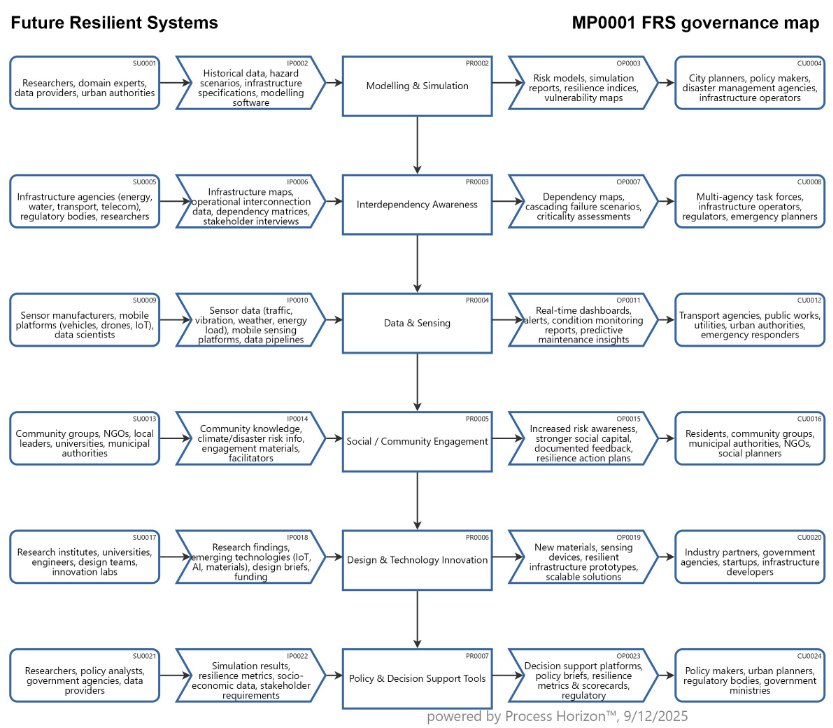Future Resilient Systems Governance

The Future Resilient Systems (FRS) programme is a major cross-disciplinary research initiative run by ETH Zurich together with Singapore through the Singapore-ETH Centre (SEC). https://frs.ethz.ch/
Resilience is inherently cross-sectoral with the SIPOC map identifying the coalition of actors & stakeholders. AI can act as the “glue” across these processes (modelling, sensing, policy, etc.) but the adoption & leadership must be supported by a holistic governance process framework.
1. National Governments
- Role: Provide mandate, resources & regulatory frameworks
- Why: Resilience cuts across ministries (transport, energy, water, health, defense). Only governments can align incentives and integrate SIPOC processes into national plans.
- AI leverage: National AI strategies can explicitly include resilience (AI for disaster response, predictive infrastructure maintenance, digital twins)
2. City & Municipal Authorities
- Role: Operationalize resilience on the ground (urban planning, emergency management, utilities)
- Why: Cities are where infrastructure interdependencies & social resilience play out most visibly.
- AI leverage: Use AI dashboards for monitoring, predictive analytics for floods/traffic/power outages, decision-support for planners
3. Critical Infrastructure Operators & Utilities
- Role: Adopt resilience modelling, sensing, interdependency awareness in energy, transport, telecom & water sectors
- Why: They own & run the systems where cascading failures happen.
- AI leverage: AI for anomaly detection, demand forecasting, asset condition monitoring
4. Academic & Research Institutions
- Role: Lead R&D, testbed pilots, train talent, ensure continuous improvement of SIPOC processes
- Why: They have expertise in simulation, design, AI methods & social science integration.
- AI leverage: Develop explainable AI, digital twins, and integrate social + technical data for resilience insights
5. Private Sector & Technology Firms
- Role: Provide scalable tools, platforms & innovation (AI, IoT, cloud, mobile sensing)
- Why: Many resilience technologies need private sector capacity to move from pilot to implementation.
- AI leverage: AI-powered sensing solutions, cloud AI services, risk analytics platforms
6. Communities & Civil Society
- Role: Co-create solutions, participate in awareness campaigns, validate social resilience tools
- Why: Social capital & trust determine if resilience measures actually work.
- AI leverage: AI-enabled participatory platforms, crowd-sourced sensing, chatbot interfaces for early warnings
7. Regional / Multilateral Bodies (e.g. ASEAN, UNDRR, World Bank)
- Role: Coordinate across borders, fund resilience initiatives, share knowledge
- Why: Disasters & shocks (floods, cyberattacks, pandemics) do not stop at borders.
- AI leverage: Cross-border data sharing platforms, AI-driven regional risk maps, standardization of resilience metrics.
Who should drive it ?
- Lead driver: National Governments & City Authorities (they have mandate & accountability)
- Co-drivers: Critical Infrastructure Operators & Research Institutions (technical capacity)
- Enablers: Private Sector & Multilateral Bodies (funding, innovation, scaling)
- Anchors: Communities (ensure adoption, legitimacy & local fit)
From a global citizen perspective Future Resilient Systems are built not just on goals but on stewardship (responsibility), agency (empowerment) & advocacy (collective voice) ensuring a livable & sustainable human habitat for generations to come.
Using the following link you can access this sandbox SIPOC model in the ProcessHorizon web app and adapt it to your needs (easy customizing) and export or print the automagically created visual AllinOne SIPOC map as a PDF document or share it with your peers: https://app.processhorizon.com/enterprises/HwUASgK4wov3G3WEWzgtTNRf/frontend

